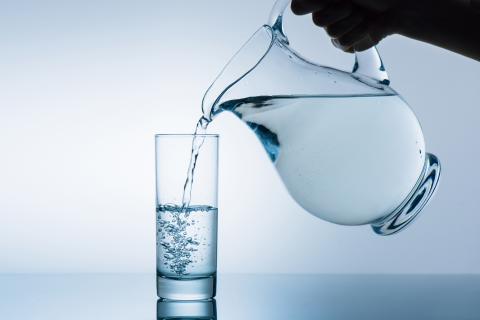
This White Paper was contributed by Karen Flicker, a medical advisor to Suppers.
If you’ve waited until you’re thirsty, you’ve waited too long to drink. It is believed that as we age, we lose the sensation of thirst; we often confuse thirst with a hunger sensation.
Signs of dehydration:
- Increased thirst
- Dry mouth
- Feeling tired or sleepy
- Decreased urine output
- Yellow urine
- Headache
- Dry skin
- Dizziness
- Fewer or no tears
- Low blood pressure
- Feeling cranky or agitated
Sweating more in humidity is an illusion: Sweat evaporation is less effective in humidity so we feel dampness on our skin. People often get into trouble in dry environments and when it’s hot and dry because they don’t feel like they are sweating, but in fact they really are, it’s just evaporating quickly.
Water and our body - what does it do?
- Removes waste
- Regulates body temp
- Helps carry nutrients and oxygen to cells, and helps the body to absorb nutrients
- Moistens oxygen for breathing
- Helps convert food into energy through cellular transport mechanism
- Protects and cushions vital organs and joints
- Makes up 75% of muscles
- Makes up 83% of blood
- Composes 75% of our brain
- Accounts for 22% of bones
Every day fluid is lost through breathing, sweating, urination and bowel movements. When we are adequately hydrated our urine should look as close to clear as possible. Along with water, small amounts of salts or electrolytes are also lost. Our bodies are constantly readjusting the balance between water losses and fluid intake.
Rule of thumb is to drink at least eight glasses a day, but optimally the formula is 1/2 body weight in ounces, so a 140 lb. person should be drinking 70 oz of water a day. This will also vary depending on activity level, climate, lifestyle and physical condition. For instance, athletes need between 1/2 and 1 liter of water per hour for exercise longer than an hour. They need to supplement with electrolytes after the first 1-2 hours of exercise.
Adding a pinch of sea salt to water helps the kidneys to retain water so you don’t urinate as quickly, sea salt also aids the body to detoxify. The best is Celtic sea salt or Himalayan sea salt, both loaded with minerals and electrolytes that help the body to function
As an athlete, if you don’t begin your workout properly hydrated or aren’t hydrating properly during activity, dehydration can occur via sweating. As little as 2% dehydration can result in a decrease in athletic performance. Of course, thirst is the number one indicator that you may be dehydrated.
The best times to hydrate:
Timing of hydration is really important for optimizing how much water your body can hold onto.
- Two glasses upon waking, this is thought to activate the internal organs. It is best to sip, not chug this, and best reclining to allow kidneys to absorb. If two glasses are too much, at least one is preferable.
- One glass 30 minutes before meals, but not closer to meal time as you don’t want to dilute stomach acid. This is thought to aid with digestion.
- One glass before bathing. This is thought to decrease blood pressure.
- One glass before bed. This is thought to help you avoid strokes and heart attacks. Water before bed can also help prevent leg cramps. (Add a pinch of sea salt to decrease cramping as well.)
- The other three glasses should be sipped throughout the day.
Drinking water at the correct time maximizes its positive effects on the human body.
Water gives the brain power for thinking by helping brain neurotransmitters function. Serotonin and melatonin are produced only when adequate brain hydration is present. Water increases the work efficiency of the brain. The brain can only tolerate a one percent loss of water.
Water generates electrical and magnetic energy inside every cell of the body. It is the main source of energy production and also regulates energy by osmotic balancing. Everything in your body needs water to live. In fact our cells live in an ocean of salt water. A chronic shortage of water in the body eventually kills some body cells.
Immune function: Dehydration suppresses the immune system, water prevents DNA damage and makes the DNA repair system more efficient.
Chemical reactions in cells produce very acidic products, like lactic acid from muscle use and cancer cells are produced in an acidic environment. Water helps to wash these acid elements from the cells take them to the liver and release them through the kidneys.
Water cleans toxic waste from the cells of the body and removes these toxins via the urine.
Water helps red blood cells get oxygen from the lungs into the cell membranes. It helps to dilute the blood preventing blood clots.
Water is the main solvent for foods, vitamins, and minerals. It breaks down foods into particles that the body can assimilate. It increases the rate of absorption of essential substances in foods and drugs.
Dehydration can contribute to hyperglycemia because when we’re even mildly dehydrated there is less liquid in our blood which means that the concentration of glucose and other nutrients is higher.
Sugar can dehydrate you if it gets to very high levels in your blood. Your kidneys will start producing more urine to try to eliminate the sugar and you subsequently lose enough fluid, you can become dehydrated. Things that can lead to hyperglycemia besides diabetes are injury, physical trauma and steroid therapy.
Water lubricates joints and makes spinal discs more shock absorbent.
Speaking of joints: When we aren’t adequately hydrated, our bodies tend to become too acidic especially if we eat a diet filled with mineral-deficient highly processed foods. There are many diet tips on the Internet about acidic foods and alkalizing foods. Look them up!
In this hyper acidic state the body will try to become more alkaline and will pull stored calcium from the bones leading to osteoporosis. To minimize the loss of bone mass you should follow an alkaline diet and have plenty of alkaline water to drink. There has been some debate about the merits of drinking alkaline water as some believe that our body is capable of adjusting its own pH. We do tend to eat highly processed foods which have an inflammatory effect on our system, so alkalizing couldn’t hurt.
Alkaline water is water that has a higher pH than tap water, which usually has a pH of 7, neutral.
The pH of bottled water can vary. Most alkaline waters are:
- Fiji (7.5)
- San Pellegrino (7.7)
- Trinity springs (9)
- Brands like Arrowhead and Poland Springs can range from 6 to 7.6
You should always drink water from glass or stainless steel containers to decrease the incidence of estrogenic compounds released through plastic degradation -- especially true when bottles of water become heated. Never drink from a plastic water bottle that’s been in a hot car, and never refill plastic water bottles.
Making your own alkaline water:
Add 1/2 teaspoon of baking soda to a liter of pure water. Test with a pH strip, available where they sell water testing supplies. The goal is to achieve about an 8.5 to 9.0 pH level. Add more baking soda as needed, but keep track of how much is needed per container so you can reproduce is easily the next time.
What are electrolytes?
They are tiny particles that carry electrical charges. Electrolytes play key roles in keeping water balances inside and outside of cells so that your muscles and organs can serve you properly. When you sweat your body loses water and electrolytes.
Function of electrolytes
- Sodium: Maintains fluid balance.
- Potassium: Prevents cramping (in sweat, potassium losses aren’t as high as sodium).
- Calcium: Regulates muscle contraction and heart rhythm; it’s the most abundant mineral in the body.
- Magnesium: Relaxes muscles. Similar to how sodium and potassium function together and balance each other, magnesium and calcium do the same. Calcium helps muscles contract and magnesium helps them relax.
- Sodium bicarbonate: Buffers lactic acid in the blood. During athletic training, lactic acid builds up and inhibits muscle contractions and leads to fatigue. Some research has shown that sodium bicarbonate intake can delay onset of fatigue and enhance endurance capacity.
Electrolyte sources (keep in mind these are needed only after at least 1-2 hours of exertion exercise, or with heavy perspiration)
- Chicken/vegetable broth
- Skim or low-fat chocolate milk
- Melon and fruits
- Salted nuts and raisins eaten together
- Electrolyte supplements like NUUN tablets/powder
- Homemade sports drink
- Homemade energy gel (good for endurance activities)
- Chia gel
Chia has hydrophilic properties and can absorb more than 12 times its weight in water. In this way it can prolong hydration, helping retain moisture and regulating more efficiently the body’s absorption of nutrients and body fluids including electrolyte balance. It is one of the most nutrient dense foods per ounce and has eight times the omega 3s as salmon does.
Supposedly the Aztecs, Mayans and Incans used chia as a diet staple and energy food. “Chia” means "strength" in Mayan and was known as “Indian running food” because runners would use them for sustenance while running or during battle. Chia seeds contain EFA’s, alpha lipoic acid, linoleic acid, are 30% protein and contain vitamins A, B, E, and D.
Chia is the “superfood” du jour: being used for nutritional and medicinal properties, endurance for athletes, for appetite suppression, weight loss, leveling blood sugar and for aiding intestinal regularity.
The seeds expand in water forming a substance that looks like gelatin. The gel-forming action is due to the soluble fiber in the chia seed. Researchers believe this also happens in the stomach when chia is consumed, thus creating a physical barrier between carbohydrates and digestive enzymes and slowing conversion of carbs into sugar which can help with endurance and metabolic regulation.
Chia gel can be used in place of fats within recipes and bulking up a meal with chia gel helps lessen the amount of food consumed; in that way it acts as an appetite suppressant. It displaces calories and fat without diluting flavor.
Chia has no known adverse effects per the literature.
References:
- Water, Hydration and Health
- Narrative Review of Hydration and Selected Health Outcomes in the General Population
- Postgraduate Symposium: Positive influence of nutritional alkalinity on bone health
- Electrolytes
- Electrolyte Intake and Major Food Sources of Sodium, Potassium, Calcium and Magnesium among a Population in Western Austria
- Chia Seeds (Salvia Hispanica L.): An Overview—Phytochemical Profile, Isolation Methods, and Application
